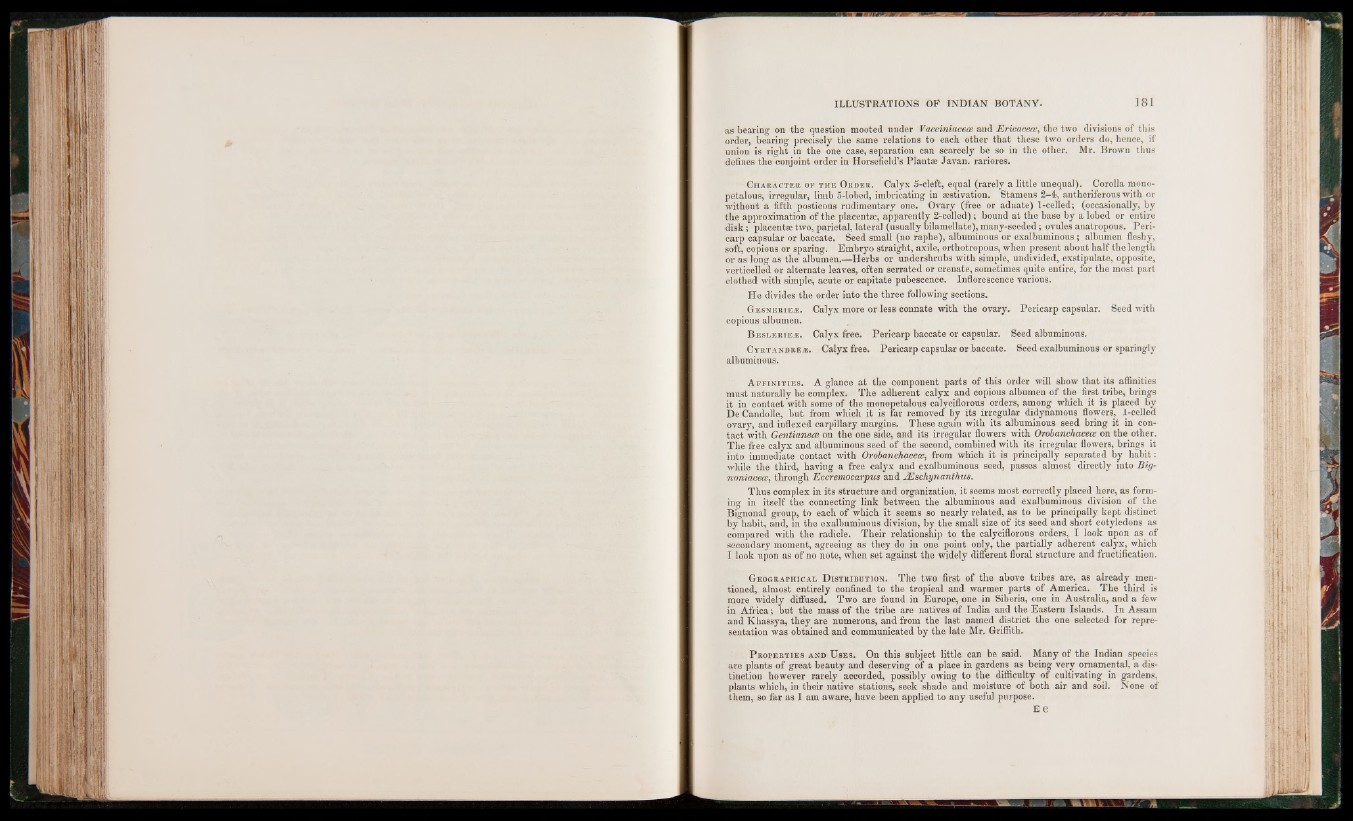
ILLUSTRATIONS OF INDIAN BOTANY. 181
as bearing on the question mooted under Vacciniaceos and Ericaceae, the two divisions of this
order, bearing precisely the same relations to each other that these two orders do, hence, if
union is right in the one case, separation can scarcely be so in the other. Mr. Brown thus
defines the conjoint order in Horsefield’s Plantse Javan, rariores.
Character of the Order. Calyx 5-cleft, equal (rarely a little unequal). Corolla mono-
petalous, irregular, limb 5-lobed, imbricating in aestivation. Stamens 2-4, antheriferous with or
without a fifth posticous rudimentary one. Ovary (free or adnate) 1-celled; (occasionally, by
the approximation of the placentae, apparently 2-celled); bound at the base by a lobed or entire
disk; placentae two, parietal, lateral (usually bilamellate), many-seeded; ovules anatropous. Pericarp
capsular or baccate. Seed small (no raphe), albuminous or exalbuminous; albumen fleshy,
soft, copious or sparing. Embryo straight, axile, orthotropous, when present about half the length
or as long as the albumen.—Herbs or undershrubs with simple, undivided, exstipulate, opposite,
verticelled or alternate leaves, often serrated or crenate, sometimes quite entire, for the most part
clothed with simple, acute or capitate pubescence. Inflorescence various.
He divides the order into the three following sections.
Gesnerie.®. Calyx more or less connate with the ovary. Pericarp capsular. Seed with
copious albumen.
B eslerie®. Calyx free. Pericarp baccate or capsular. Seed albuminous.
Cyrt andre*:. Calyx free. Pericarp capsular or baccate. Seed exalbuminous or sparingly
albuminous.
Af f in it ie s . A glance at the component parts of this order will show that its affinities
must naturally be complex. The adherent calyx and copious albumen of the first tribe, brings
it in contact with some of the monopetalous calyciflorous orders, among which it is placed by
De Candolle, but from which it is far removed by its irregular didynamous flowers, 1-celled
ovary, and inflexed carpillary margins. These again with its albuminous seed bring it in contact
with Gentianece on the one side, and its irregular flowers with Orobanchaceos on the other.
The free calyx and albuminous seed of the second, combined with its irregular flowers, brings it
into immediate contact with Orobanchaceos, from which it is principally separated by habit:
while the third, having a free calyx and exalbuminous seed, passes almost directly into Big-
noniaceoe, through Eccremocarpus and JEschynanthus.
Thus complex in its structure and organization, it seems most correctly placed here, as forming
in itself the connecting link between the albuminous and exalbuminous division of the
Bignonal group, to each of which it seems so nearly related, as to be principally kept distinct
by habit, and, in the exalbuminous division, by the small size of its seed and short cotyledons as
compared with the radicle. Their relationship to the calyciflorous orders, I look upon as of
secondary moment, agreeing as they do in one point only, the partially adherent calyx, which
I look upon as of no note, when set against the widely different floral structure and fructification.
Geographical D istribution. The two first of the above tribes are, as already mentioned,
almost entirely confined to the tropical and warmer parts of America. The third is
more widely diffused. Two are found in Europe, one in Siberia, one in Australia, and a few
in Africa; but the mass of the tribe are natives of India and the Eastern Islands. In Assam
and Khassya, they are numerous, and from the last named district the one selected for representation
was obtained and communicated by the late Mr. Griffith.
P roperties and Uses. On this subject little can be said. Many of the Indian species
are plants of great beauty and deserving of a place in gardens as being very ornamental, a distinction
however rarely accorded, possibly owing to the difficulty of cultivating in gardens,
plants which, in their native stations, seek shade and moisture of both air and soil. None of
them, so far as I am aware, have been applied to any useful purpose.
E e